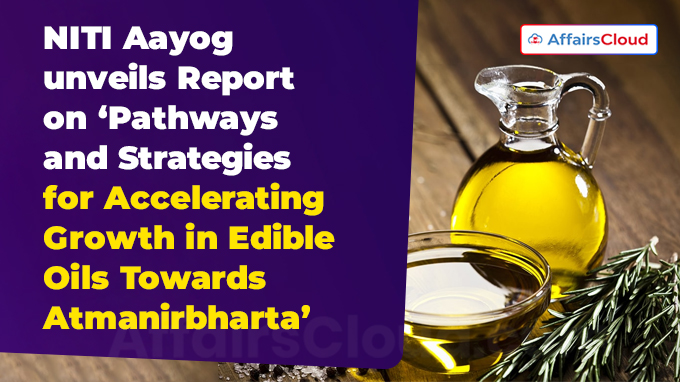 On 29th August 2024, Suman Bery, Vice-Chairperson, National Institution for Transforming India (NITI Aayog) released report titled “Pathways and Strategies for Accelerating Growth in Edible Oil Towards the Goal of Atmanirbharta”. The report was presented by Dr. Neelam Patel, Senior Advisor (Agriculture), NITI Aayog.
On 29th August 2024, Suman Bery, Vice-Chairperson, National Institution for Transforming India (NITI Aayog) released report titled “Pathways and Strategies for Accelerating Growth in Edible Oil Towards the Goal of Atmanirbharta”. The report was presented by Dr. Neelam Patel, Senior Advisor (Agriculture), NITI Aayog.
- Overall, the strategic interventions proposed by the report can help to achieve the projected edible oil supplies of 36.2 million tonnes (MT) and 70.2 MT by 2030 and 2047 respectively.
- The report is based on the valuable information gained from a primary field survey conducted by NITI Aayog.
- The survey includes a sample of 1,261 farmers across 7 major oilseed-growing states – Rajasthan, Maharashtra, Madhya Pradesh (MP), Uttar Pradesh (UP), Haryana, Andhra Pradesh (AP), and Karnataka.
Reasons for Increase in Import of Edible Oil:
i.The report underscored that over the last decades, per capita consumption of edible oil in India has increased exponentially, reaching a 19.7 kilogram (kg) per year.
- This increase in demand has significantly outpaced domestic production which led to heavy dependence on imports to meet both domestic and industrial requirements.
ii.As per the report, India imported 16.5 MT of edible oils in financial year 2022-23 (FY23), with domestic production fulfilling only 40% to 45% of the country’s needs.
- This situation poses challenge to the country’s goal of achieving self-sufficiency in edible oils.
Point to Note: Under a Business-As-Usual (BAU) scenario, the national supply of edible oil is estimated to increase to 16 MT by 2030 and 26.7 MT by 2047.
Edible Oil Demand Projections:
The report has used 3 different approaches for demand forecasting to have a multifaceted understanding of future edible oil needs:
i.Static/ Household Approach: This approach uses population projections and baseline per capita consumption data, assuming a short-term static pattern in consumption behavior.
ii.Normative Approach: This approach is based on the recommended healthy intake levels established by the Indian Council of Medical Research-National Institute of Nutrition (ICMR-NIN).
iii.Behavioristic Approach: This approach recognizes the potential for behavioral shifts in food consumption patterns due to changing lifestyles and dietary habits driven by increasing income levels and price fluctuations.
Key Projections on Demand-Supply Gap:
i.In the BAU situation, the edible oil demand of country will reach Scenario-I by 2028 and Scenario-II by 2038 where under the high-income growth circumstance, assuming an estimated annual growth of 8%, the country’s edible oil demand will reach Scenario-I as early as 2025 and Scenario-II by 2031. This shows even higher demand due to increased economic growth.
ii.The projections based on the Static/Household Approach indicate a smaller demand-supply gap of 14.1 MT and 5.9 MT by 2030 and 2047 respectively.
- However, if the per capita consumption suggested by ICMR-NIN is followed, the country is estimated to have a surplus of 0.13 MT and 9.35 MT by 2030 and 2047 respectively.
Key Strategic Interventions:
i.The report has recommended several strategic interventions to bridge the existing demand-supply gap of edible oil and ensure long-term sustainability. The proposed strategy is based on 3 key pillars such as: Crop Retention and Diversification; Horizontal Expansion; and Vertical Expansion.
ii.The Horizontal Expansion strategy aims to strategically increase the cultivation area of edible oil crops.
iii.The Vertical Expansion aims to enhance the yield of existing oilseed cultivation, through improved farming practices, better-quality seeds, and advanced production technologies.
Key Projections:
i.The report projected that by strategically retaining and diversifying oilseed crops and focusing on areas potentially lost to cereal cultivation will increase the country’s edible oil production by 20% in 9 states, with additional oil production of 7.36 MT and reduction in import dependence by 2.1MT.
ii.The report suggested that by utilizing 1/3rd (33%) rice fallow area in 10 states for oilseed cultivation can increase the oilseed production by 3.12 MT and reduce import by 1.03 MT.
- For example: the cultivation of linseed, sesame and mustard in Madhya Pradesh (MP), Chhattisgarh can increase the edible oil production to 0.85 MT.
- Also, states like Bihar and Jharkhand have the potential to reach 0.62 MT by introducing linseed, sunflower, safflower, and mustard.
- While, West Bengal and Odisha with the cultivation of linseed, sesame, sunflower, safflower, and mustard, can increase the production of edible oil to 0.68 MT and 0.32 respectively.
iii.The report recommended that by increasing the yield gap from 12% in castor to 96% in sunflower through adoption of improved technologies and effective management practices, for example: by using the vertical expansion, India’s domestic oilseed production will be increased by 17.4 MT and will further reduce edible oil imports by 3.7 MT.
iv.Through targeted expansion, Palm Oil alone, can increase the production of edible oil to 34.4 MT, which play a major in bridging the existing demand-supply gap.
- The report suggested that effort should focus on capitalizing on the untapped potential identified by Indian Council of Agricultural Research-Indian Institute of Oil Palm Research (ICAR-IIOPR) in the 284 districts, which projects an additional 2.43 Million hectares (Mha) of land across the country for oil palm cultivation.
- Also, by utilizing two-thirds of the highly suitable areas of wastelands located in districts (i.e. 6.18 Mha) identified by ICAR-IIOPR can help for horizontal expansion.
v.As per the report, the potential increase in edible oil production estimated from the proposed strategic interventions combined with the existing production level is expected to achieve self-sufficiency with latest growth trend i.e. Compound Annual Growth (CAGR) of 3%.
vi.The report has outlined the strategic interventions to increase domestic oil production of India by 43.5 Million Tonnes (MT), to narrow the import gap and put country on a trajectory towards self-sufficiency.
Key Recommendations:
The report concluded with various recommendations that can help in achieving self-sufficiency in edible oils, including: focusing on area retention of oilseeds, seed traceability and quality assurance, adoption of improved and advanced production technologies, value addition through processing and refining, fostering public-private partnerships, expanding the scope of the National Mission on Edible Oils, among others.
About National Institution for Transforming India (NITI Aayog):
Chairperson- Narendra Modi (Prime Minister of India)
Vice-Chairperson- Suman Bery
Headquarters- New Delhi, Delhi
Established in- 2015




